Security issues in nanotechnology
Security issues in nanotechnology

Photo: Brandão, Humberto
The use of nanotechnology has been putting nanoparticles and nanostructures in contact with live organisms in ways not yet fully understood. In agriculture, this interaction can occur on a large scale, such as in the applications of controlled release nanostructure-encapsulated pesticides whose toxicity inherent to the drug release system still requires continual verification. Cases like this have motivated the proposal of this project, whose objective was to evaluate the potential impact on living organisms from the use of nanomaterials engineered and produced for the agricultural and food production chains. The main targets of study were nanoparticles aimed at controlled release of pesticides or fertilizers, nanoproducts with bactericidal of fungicidal properties, nanocomposites used in food, edible nanostructured films, among others. The project prioritized the toxicological assessment on plant cells, animal cells and embryos and laboratory animals, to construct a general overview of the interference of nanostructured nanoparticles and nanostructured systems on living organisms, and on technologies related to agriculture. These results were compared to data from characterization tests of the materials produced by other projects, and each tested structure was correlated to toxicity indicators concerning one or more biological systems. Additionally, events of alterations in the genetic structure were evaluated on a limited basis. Thus, the results were directed to provide the basis for future recommendations of nanometric systems in agriculture, and to reorient ongoing research on the subject. Finally, the team also evaluated aspects of perception of toxicological and environmental impact of nanotechnology in order to integrate the different developments in the course of this project and the other interconnected ones. The goals were achieved regarding the analysis of the impact of nanoparticles and nanostructured systems by means of either in vitro tests (genotoxicity of nanoparticles) in cultured cells, bovine embryos obtained from disposal of abattoir disposals, and laboratory animals. These activities are currently being continued in a new project, along with the reorientation on the ongoing research efforts on the subject.
Ecosystem: Amazonic, Extreme South, Atlantic Forest, Pantanal, Caatinga Region and Mixed forests, Cerrados Region
Status: Completed Start date: Fri Apr 01 00:00:00 GMT-03:00 2011 Conclusion date: Tue Mar 31 00:00:00 GMT-03:00 2015
Head Unit: Embrapa Dairy Cattle
Project leader: Humberto de Mello Brandão
Contact: humberto.brandao@embrapa.br
Keywords: avaliação de riscos, Nanotecnologia, toxicologia
